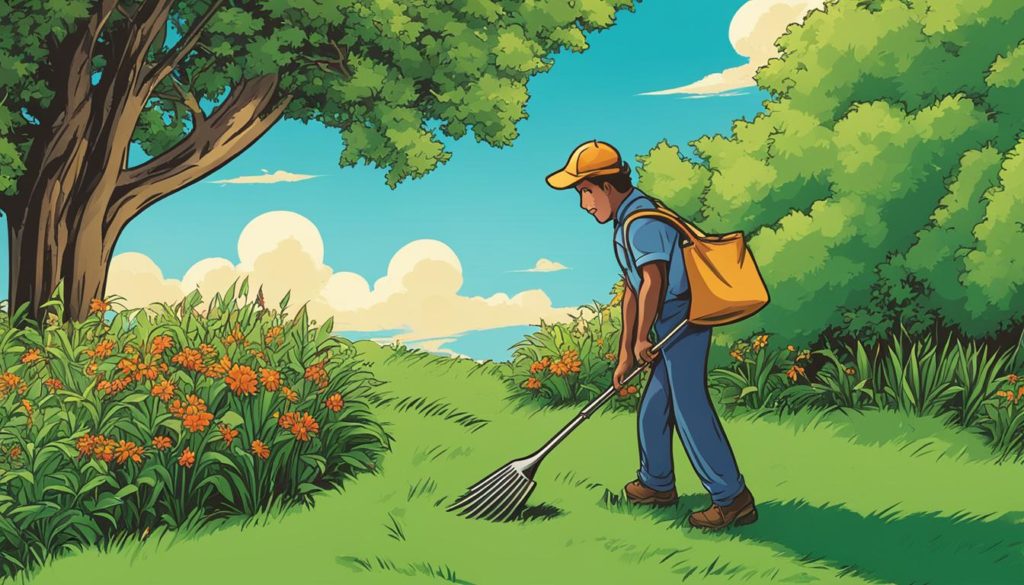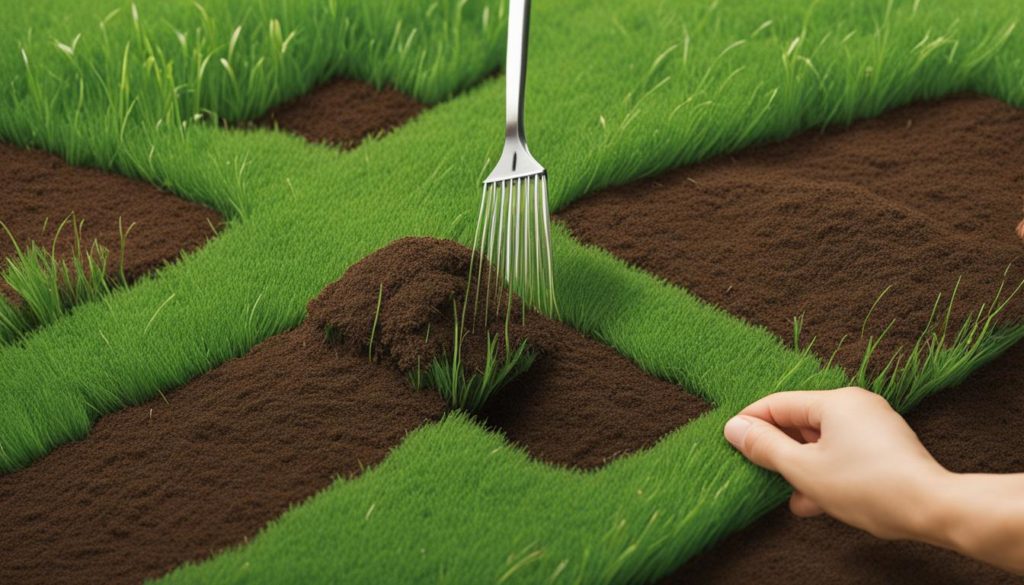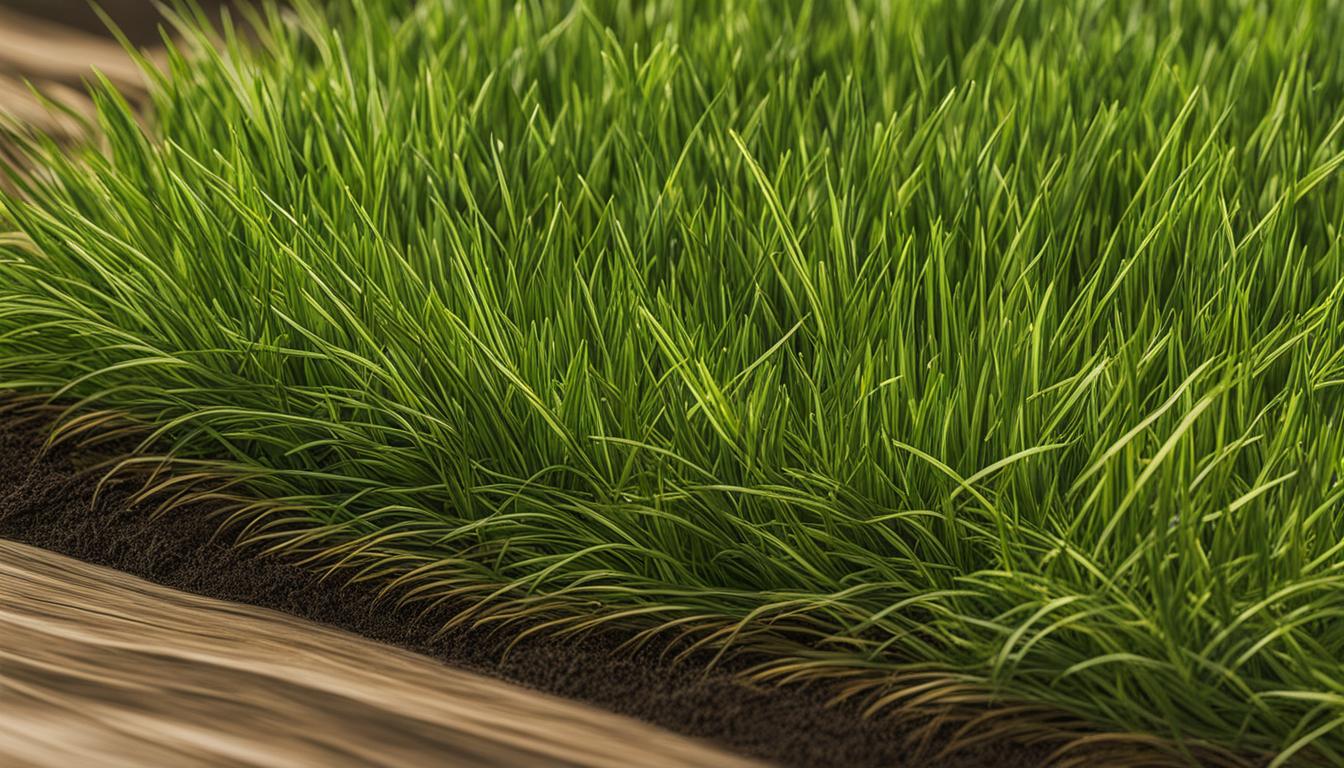Growing and maintaining a lush, vibrant lawn in Florida can be a rewarding experience. However, it requires careful attention to detail and knowledge of the best practices for grass repair and maintenance. Whether you’re dealing with damaged grass, troubleshooting issues, or simply looking for tips to maintain healthy grass in Florida, this guide has got you covered. From selecting the right grass seed to implementing proper seeding techniques and addressing common lawn problems, you’ll find all the information you need to achieve a beautiful Florida lawn.
- Choose the best grass seed for your Florida lawn based on climate, soil type, and intended use.
- Prepare your lawn properly before seeding by removing debris, addressing soil pH and nutrient deficiencies, and ensuring proper drainage.
- Use proper seeding techniques, including even grass seed distribution and adequate watering.
- Consider low-maintenance grass options for your Florida lawn to save time and effort in lawn care.
- Maintain your Florida lawn year-round by watering, mowing, and fertilizing appropriately.
Key Takeaways:
- Selecting the right grass seed is crucial for a healthy Florida lawn.
- Proper preparation of the soil is essential for successful grass growth.
- Utilize recommended seeding techniques for optimal results.
- Consider low-maintenance grass varieties for easier lawn care.
- Maintain your Florida lawn year-round with proper watering, mowing, and fertilizing techniques.
Selecting the Best Grass Seed for Your Florida Lawn
When it comes to choosing the best grass seed for your Florida lawn, it’s important to consider several factors to ensure successful growth and maintenance. The climate, soil type, and your preferences for appearance and maintenance all play a role in selecting the right grass seed. In Florida, you have options between warm-season grasses and cool-season grasses, each with their own unique characteristics and requirements.
For those residing in hotter regions, warm-season grasses like Bermuda and Zoysia are excellent choices. Bermuda grass is known for its heat tolerance and ability to withstand heavy foot traffic, making it ideal for lawns that experience a lot of activity. Zoysia grass, on the other hand, has a deep root system and is highly drought-tolerant, making it a great option for areas with limited water availability.
If you live in an area that experiences cooler temperatures, opting for cool-season grasses like Kentucky bluegrass and fescue is recommended. These grasses thrive in cooler climates and are known for their ability to withstand colder winters. For those residing in the Transition Zone, which covers a large portion of the Midwest and Mid-Atlantic regions, a combination of cool-season and warm-season grasses may be necessary.
Factors to Consider
When selecting grass seed for your Florida lawn, it’s crucial to consider the following factors:
- Climate: Choose a grass variety that is well-suited to Florida’s climate, taking into account factors like temperature, humidity, and rainfall patterns.
- Soil Type: Assess the soil type in your lawn, as different grass species have specific soil requirements. Some grasses thrive in sandy soils, while others prefer clay or loam.
- Appearance and Maintenance: Consider the desired appearance and level of maintenance for your lawn. Some grasses require regular mowing and fertilization, while others are more low-maintenance.
- Sun and Shade Patterns: Evaluate the sun and shade patterns in your yard to choose a grass variety that can thrive in the available light conditions.
- Intended Use: Determine how you plan to use your lawn, whether it’s for recreational activities, landscaping, or simply visual appeal. Certain grass species are more suitable for high-traffic areas, while others are better for ornamental purposes.
By considering these factors and conducting proper research, you can select the best grass seed for your Florida lawn, ensuring a healthy and vibrant outdoor space.
| Grass Seed | Climate | Soil Type | Maintenance |
|---|---|---|---|
| Bermuda grass | Hot and humid | Well-draining | Moderate |
| Zoysia grass | Hot and humid | Well-draining | Low |
| Kentucky bluegrass | Cooler temperatures | Moist, fertile | Moderate |
| Fescue grass | Cooler temperatures | Wide range | Low |
Preparing Your Florida Lawn for Seeding
Properly preparing your Florida lawn before seeding is crucial for successful grass growth. Follow these essential steps to ensure your lawn is ready for the seeding process:
1. Removing Debris from Lawn Area
Begin by clearing the area where you plan to plant grass seed. Remove any rocks, sticks, leaves, or other debris that may hinder grass growth. This will create a clean and even surface for the seeds to take root.
2. Addressing Soil pH and Nutrient Deficiencies
Conduct a soil test to determine the pH level and nutrient content of your soil. Based on the test results, address any soil pH imbalances by adding lime to raise the pH or sulfur to lower it. Additionally, consider adding appropriate fertilizers or soil amendments to supplement any nutrient deficiencies found in the soil.
3. Leveling the Soil Surface
Even out any uneven areas in your lawn by leveling the soil surface. Use a rake or shovel to smooth out bumps and fill in depressions. This will provide an even surface for the grass seed to germinate and establish itself.
4. Addressing Drainage Issues
Ensure proper drainage in your lawn by addressing any existing issues. Install drainage solutions such as French drains or dry wells to redirect excess water away from the lawn. Alternatively, consider regrading the slope of your lawn to promote better water drainage.
5. Detaching and Aerating the Lawn
To promote better seed-to-soil contact and alleviate compaction, consider detaching and aerating your lawn. Detaching involves removing dead grass and thatch from the surface, while aerating involves creating small holes in the soil to improve air and water circulation. These practices enhance the overall health and condition of your lawn.

By following these steps, you can ensure that your Florida lawn is properly prepared for seeding. Taking the time to prepare the soil and address any underlying issues will set the stage for successful grass growth and a vibrant, healthy lawn.
Seeding Techniques for Florida Lawns
Properly seeding your Florida lawn is essential to ensure successful grass growth. From distributing grass seed evenly to providing the right amount of water and fertilizer, following the correct seeding techniques can help you achieve a lush and healthy lawn. Here are some key practices to consider:
Distribution of Grass Seed
When seeding your Florida lawn, it’s important to distribute the grass seed evenly to promote uniform growth. Use a seed spreader to ensure an even distribution. Adjust the spreader settings according to the recommended seeding rates for your specific grass seed variety. This will help prevent patchy areas and ensure that the grass seed has proper access to sunlight, water, and nutrients.
Overlapping Passes
To achieve optimal grass coverage, it’s recommended to make overlapping passes when spreading the seed. This technique helps fill in any gaps or areas that may have been missed during the initial pass. By overlapping the passes slightly, you can ensure that all areas of your lawn receive sufficient grass seed for healthy growth.
Bi-Directional Seeding
Consider using a bi-directional seeding method for your Florida lawn. This technique involves spreading the grass seed in two directions, such as north-south and east-west. Bi-directional seeding helps ensure even distribution of the seed, reducing the likelihood of uneven growth or sparse areas.
Watering and Fertilizing Newly Seeded Lawn
After seeding your Florida lawn, it’s crucial to provide adequate water and fertilizer to support germination and establishment. Water the newly seeded lawn regularly to keep the soil moist, but be careful not to overwater, as this can lead to disease and shallow root growth. Follow the recommended watering schedule for your specific grass seed variety.
Apply a starter fertilizer to provide the necessary nutrients for healthy seedling growth. Pay attention to the specific fertilizer requirements of your grass seed variety and follow the recommended application rates. Be sure to follow all manufacturer instructions when applying fertilizer to avoid over-application, which can damage the newly seeded lawn.
By implementing these seeding techniques and providing proper care, you can increase the chances of successful grass growth and achieve a vibrant lawn in Florida.

Low-Maintenance Grasses for Florida Lawns
When it comes to maintaining a beautiful lawn in Florida, choosing the right grass variety can make a significant difference in the amount of time and effort required for upkeep. Low-maintenance grasses are an excellent choice for Florida lawns, as they are specifically designed to withstand the challenging climatic conditions of the region, including heat, humidity, and occasional drought. Let’s explore some popular low-maintenance grass options for Florida lawns:
Zoysia Grass
Zoysia grass is known for its deep root system, which helps it withstand drought and requires less watering compared to other grass varieties. It also has excellent heat and disease resistance, making it an ideal choice for Florida lawns.
Bermuda Grass
Bermuda grass is highly drought-resistant and can tolerate heavy foot traffic, making it a great option for lawns that receive a lot of use. It has good heat and disease resistance, making it a reliable choice for Florida’s hot and humid climate.
Buffalo Grass
Buffalo grass is a low-growing, drought-tolerant grass variety that thrives in southwestern regions of Florida. It requires minimal water and maintenance, making it an excellent choice for those looking for a low-maintenance lawn option.
Other low-maintenance grass options for Florida lawns include St. Augustine grass, Fescue grass, Blue Grama grass, and Bahiagrass. Each grass variety has its own unique characteristics and benefits, so consider factors such as shade tolerance, water requirements, and the specific growing conditions of your lawn when making your selection.

Table: Low-Maintenance Grass Options for Florida Lawns
| Grass Variety | Characteristics |
|---|---|
| Zoysia Grass | Deep root system, drought and heat resistant |
| Bermuda Grass | Drought-resistant, tolerant of heavy foot traffic |
| Buffalo Grass | Low-growing, drought-tolerant |
| St. Augustine Grass | Shade-tolerant, minimal maintenance |
| Fescue Grass | Resilient to cold winters, low water requirements |
| Blue Grama Grass | Thrives in dry climates, minimal water requirements |
| Bahiagrass | Resilient in poor soil conditions |
By choosing low-maintenance grasses for your Florida lawn, you can enjoy a beautiful, thriving outdoor space with less time and effort spent on maintenance.
Lawn Care Tips for Florida Grass
Maintaining a healthy Florida lawn requires proper care and maintenance. Follow these essential lawn care tips to keep your Florida grass looking lush and vibrant:
- Watering: Water your Florida grass deeply and infrequently to encourage deep root growth. Aim for 1-1.5 inches of water per week, including rainfall. Water in the early morning to allow for proper absorption and reduce the risk of disease.
- Mowing: Set your mower to the appropriate height for your grass variety. Generally, warm-season grasses should be mowed at a height of 2-3 inches, while cool-season grasses can be cut slightly shorter at 1.5-2.5 inches. Avoid cutting more than one-third of the grass blade length at a time to prevent scalping.
- Fertilizing: Apply fertilizer to your Florida lawn based on soil test results and the specific nutrient needs of your grass variety. Opt for slow-release fertilizers to provide a steady supply of nutrients over time. Follow recommended fertilization schedules and avoid over-fertilizing, as it can lead to excessive growth and nutrient runoff.
By following these lawn care tips, you can maintain a healthy and vibrant Florida lawn throughout the year.
Note:
Proper lawn care practices are crucial for the health and appearance of your Florida grass. However, it’s important to note that specific care requirements may vary depending on the grass species you have in your lawn. Always refer to the care recommendations provided by the manufacturer or consult with a local lawn care professional for tailored advice.
Remember to regularly monitor your Florida lawn for any signs of stress, pests, or diseases. Early detection and prompt action can help prevent further damage and maintain the overall health and beauty of your lawn.
Troubleshooting Florida Grass Issues
Florida grasses can face various issues, and understanding how to troubleshoot these problems is crucial for maintaining a healthy and vibrant lawn. Some common issues that homeowners encounter with their Florida grass include brown spots, weed infestations, and pest problems.
Brown Spots in Florida Lawn
One of the most common issues that homeowners face with their Florida grass is the development of brown spots in the lawn. Brown spots can be caused by a variety of factors, including improper watering, nutrient deficiencies, diseases, or pests. To troubleshoot brown spots, it’s important to identify the underlying cause. Conduct a thorough inspection of the affected areas and consider factors such as watering practices, nutrient levels, and signs of pests or diseases. Once the cause is identified, take appropriate measures to address the issue. This may include adjusting watering schedules, applying the necessary nutrients, or utilizing pest control methods.
Weed Control in Florida Lawns
Weeds can quickly invade a Florida lawn and negatively impact its appearance and health. To effectively control weeds, it’s important to employ both pre-emergent and post-emergent herbicides. Pre-emergent herbicides can help prevent weed seeds from germinating, while post-emergent herbicides are designed to kill existing weeds. When using herbicides, always follow the manufacturer’s instructions and take care to avoid applying them to areas of desirable grass. Additionally, maintaining a healthy lawn through regular watering, mowing, and fertilization can help prevent weed growth by creating a dense turf that inhibits weed establishment.
Pest Control for Florida Lawns
Insects and other pests can also cause damage to Florida lawns. Common pests in Florida include mole crickets, grubs, and chinch bugs. Regular monitoring for signs of pest activity is essential for early detection and control. If pests are identified, appropriate pest control methods should be applied. This may include the use of insecticides, biological control methods, or cultural practices such as proper watering and mowing techniques. It’s important to consult with a professional or refer to reputable resources to ensure the safe and effective control of lawn pests.
| Problem | Cause | Troubleshooting Steps |
|---|---|---|
| Brown Spots | Improper watering, nutrient deficiencies, diseases, pests | Identify the underlying cause, adjust watering and nutrient levels, apply appropriate treatment for diseases or pests |
| Weeds | Seeds from neighboring lawns or gardens, lack of a dense turf | Use pre-emergent herbicides to prevent weed seed germination, apply post-emergent herbicides to kill existing weeds, maintain a healthy lawn through regular maintenance practices |
| Pests | Mole crickets, grubs, chinch bugs | Monitor for signs of pest activity, apply appropriate pest control methods, consult with a professional if necessary |
Restoring Damaged Grass in Florida
If your Florida grass is damaged or has bare patches, there are restoration techniques you can use to revive it. One effective method is overseeding, which involves spreading grass seed over the damaged areas to fill in bare spots and promote new grass growth. Ensure proper seed-to-soil contact by lightly raking the soil before overseeding, and provide adequate watering to keep the soil moist for germination.
Another option for restoring damaged grass in Florida is sodding. This involves installing rolls or patches of high-quality sod over the bare areas. Sodding can provide an instant solution and faster results compared to overseeding, but it is typically more expensive. Choose a sod variety that is well-suited to Florida’s climate and soil conditions for the best results.
Whether you choose overseeding or sodding, proper preparation is key. Make sure to remove any debris, rocks, or weeds from the area beforehand, and level the soil surface as needed. Address any underlying issues that may have caused the damage, such as poor drainage or soil nutrient deficiencies, to prevent further problems in the future.
| Method | Description |
|---|---|
| Overseeding | Spreading grass seed over damaged areas to promote new growth |
| Sodding | Installing rolls or patches of high-quality sod over bare areas for instant results |
Restoring damaged grass in Florida requires patience and proper care. Regularly water and fertilize the restored areas, following the specific requirements of the grass variety you have chosen. Monitor the progress of the restoration and make any necessary adjustments to your lawn care routine. With time and attention, you can successfully revive your damaged grass and enjoy a healthy and lush lawn.
Maintaining a Lush Florida Lawn Year-Round
To keep your Florida lawn healthy and vibrant throughout the year, it’s important to follow proper lawn care techniques. By adopting these Florida grass care techniques, you can ensure your lawn stays green and lush all year long.
Regular Watering
Watering is a crucial aspect of maintaining healthy grass in Florida. The specific watering needs may vary depending on the grass variety you have, but a general rule of thumb is to provide 1-1.5 inches of water per week. However, it’s important to adjust the watering schedule based on rainfall, soil moisture levels, and the specific grass variety’s water requirements. Water deeply and infrequently to encourage deep root growth and avoid shallow roots that are more susceptible to drought stress.
Proper Mowing Practices
Mowing your Florida grass at the right height is essential for its overall health. Set your mower blades to the recommended height for your specific grass variety, ensuring you don’t cut more than one-third of the grass blade length at a time. Scalping the lawn can weaken the grass and make it more susceptible to stress and weed invasion. Additionally, consider the weather conditions when mowing and adjust the height accordingly. During times of drought or extreme heat, mowing at a slightly taller height can help shade the soil, reduce evaporation, and conserve moisture.
Regular Fertilization
Fertilization plays a vital role in maintaining a healthy Florida lawn. Conduct a soil test to determine the specific nutrient needs of your grass variety and apply fertilizers accordingly. Follow the recommended fertilization schedule, typically applying fertilizer in the spring and fall for warm-season grasses. Use slow-release fertilizers to provide a steady supply of nutrients over time and prevent burning the grass. Avoid overfertilization, as it can lead to excessive growth, thatch buildup, and nutrient runoff.
| Maintenance Tasks | Recommended Frequency |
|---|---|
| Watering | 1-1.5 inches per week, adjusting based on rainfall |
| Mowing | Regularly, following the recommended height |
| Fertilizing | Spring and fall for warm-season grasses |
| Weeding | As needed, using appropriate weed control methods |
| Pest control | As needed, using suitable pest control measures |
By following these Florida lawn maintenance year-round practices, you can enjoy a vibrant and healthy lawn that enhances the beauty of your outdoor space.
Benefits of Low-Maintenance Grass for Florida Lawns
Choosing low-maintenance grass for your Florida lawn offers numerous advantages that can save you time and effort while still ensuring a lush and vibrant outdoor space. Here are some key benefits:
- Water-saving: Low-maintenance grass varieties are often more drought-resistant and require less watering compared to high-maintenance grasses. They can withstand Florida’s hot and humid climate, reducing the need for frequent irrigation.
- Time-saving: Low-maintenance grasses require less mowing, fertilizing, and overall maintenance. With their slower growth rate and ability to tolerate longer periods between mowing, you can spend less time and effort on lawn care tasks.
- Resilience: These grass varieties are known for their ability to withstand various weather conditions, foot traffic, and other stress factors. They have specific characteristics like heat tolerance, shade tolerance, and resistance to common lawn issues, making them ideal for Florida’s challenging environment.
- Cost-effective: By choosing low-maintenance grass that requires fewer inputs like water, fertilizers, and pesticides, you can save money on your lawn care expenses over time. Additionally, lower maintenance needs mean fewer equipment and labor costs.
The benefits of low-maintenance grass extend beyond time and cost savings. They also contribute to the overall health and sustainability of your Florida lawn. With their exceptional resilience and adaptability, these grass varieties can provide a beautiful and hassle-free outdoor space for you to enjoy.
“By choosing low-maintenance grass for your Florida lawn, you can save time and effort while still enjoying a lush and vibrant outdoor space.”
| Advantages of Low-Maintenance Grass | Description |
|---|---|
| Water-saving | Low-maintenance grass varieties are more drought-resistant and require less watering. |
| Time-saving | Low-maintenance grasses require less mowing, fertilizing, and overall maintenance. |
| Resilience | These grass varieties can withstand various weather conditions, foot traffic, and other stress factors. |
| Cost-effective | Choosing low-maintenance grass can result in cost savings on water, fertilizer, and pest control. |
Importance of Choosing the Right Grass for Florida Lawns
Choosing the right grass for your Florida lawn is crucial for maintaining a healthy and vibrant outdoor space. The climate, soil conditions, and sunlight patterns in Florida can vary significantly, and different grass species have specific qualities and requirements that can impact their performance. By selecting the appropriate grass species, you can ensure that your lawn thrives and remains resilient to the challenges of the Florida environment.
When choosing the right grass for your Florida lawn, consider factors such as the USDA hardiness zone, soil type, shade tolerance, foot traffic resistance, and water requirements. These factors will help you determine which grass species are best suited for your specific lawn conditions. For example, if you have areas that receive a lot of shade, selecting a grass species with shade tolerance, such as St. Augustine grass, would be beneficial. Similarly, if you have a lawn that experiences heavy foot traffic, choosing a grass variety like Bermuda grass, which is known for its durability, would be a wise choice.
The impact of choosing the right grass goes beyond initial establishment. It also affects the ongoing care and maintenance of your Florida lawn. Different grass species have varying needs in terms of watering, mowing, fertilizing, and overall maintenance. By selecting the appropriate grass for your lawn, you can streamline your lawn care practices and ensure that you’re providing the right conditions for your grass to thrive. This not only saves you time and effort but also helps you achieve a lush and beautiful lawn all year round.
In conclusion, selecting the right grass for your Florida lawn is essential for successful lawn care and maintenance. By considering factors like climate, soil conditions, shade tolerance, and foot traffic resistance, you can choose a grass species that will thrive in your specific lawn conditions. This will not only ensure a healthy and vibrant lawn but also streamline your lawn care practices for long-term success.
Conclusion
Maintaining a healthy and vibrant lawn in Florida requires proper grass selection, preparation, and ongoing care. By selecting the right grass seed, assessing your soil, and following recommended seeding and maintenance techniques, you can achieve a lush and thriving Florida lawn.
Low-maintenance grass varieties can reduce the time and effort required for lawn care while still providing a beautiful outdoor space. These grasses are often more drought-resistant and can withstand Florida’s hot and humid climate. They also have specific characteristics like shade tolerance, heat tolerance, and foot traffic resistance, making them ideal choices for your Florida lawn.
Remember to address any lawn issues promptly and adjust your lawn care practices based on your grass variety and local climate. Regularly watering, mowing, and fertilizing your lawn are essential for its health and appearance. By adopting the right approach and investing time in fixing and maintaining your grass, you can enjoy a lush and stunning lawn that enhances the beauty of your Florida home.
So, whether you are considering a complete grass restoration or simply looking to revitalize your existing lawn, with the proper knowledge, techniques, and dedication, you can successfully achieve a vibrant and well-maintained grass lawn in Florida.
Why go with Turbo Turf Landscaping for your lawn service needs?
Turbo Turf Landscaping is a family owned and operated full service lawn care provider. We proudly serve the East Orlando area including Avalon Park, Chuluota, Timber Springs, Waterford Lakes, Oviedo, and the UCF area. Our customer’s satisfaction is our number one concern as you should be able to enjoy your lawn in your free time. Please contact us at our Contact Us page (here) to receive a free estimate.
FAQ
How do I choose the right grass seed for my Florida lawn?
When selecting grass seed for your Florida lawn, consider factors like climate, soil type, sun and shade patterns, and intended use of the lawn. Cool-season grasses are suitable for cooler regions, while warm-season varieties excel in hotter climates. The Transition Zone requires grass seed blends combining both cool-season and warm-season varieties. Assess your soil’s pH, nutrient levels, and drainage before choosing the appropriate grass seed variety.
How do I prepare my Florida lawn for seeding?
Properly preparing your Florida lawn before seeding is essential. Start by removing debris, rocks, weeds, and vegetation from the area where you plan to plant grass seed. Conduct a soil test to determine your soil’s pH level, nutrient content, and texture. Based on the soil test results, address soil pH and nutrient deficiencies. Level the soil surface to ensure an even lawn and address any drainage issues. Consider options like detaching and aerating the lawn to promote better seed-to-soil contact.
What are the proper seeding techniques for Florida lawns?
Proper seeding techniques are crucial for the successful establishment of grass seed in Florida lawns. Use a seed spreader for even distribution of grass seed, adjusting the spreader settings according to the recommended seeding rates. Overlap passes slightly to avoid gaps or uneven coverage. Consider bi-directional seeding for optimal coverage. After seeding, water the lawn regularly to keep the soil moist and promote germination. Follow appropriate fertilization practices for newly seeded lawns.
What are some low-maintenance grass options for Florida lawns?
There are several low-maintenance grass options for Florida lawns, including Zoysia grass, Bermuda grass, Buffalo grass, St. Augustine grass, Fescue grass, Blue Grama grass, and Bahiagrass. Each grass variety has its own characteristics and is suitable for different Florida climates and lawn conditions. Choose the grass variety that best suits your lawn’s needs and local climate.
What are some lawn care tips for Florida grass?
To maintain a healthy Florida lawn, water it appropriately, mow it at the recommended height, and fertilize it based on soil test results and the specific nutrient needs of the grass variety. Keep an eye out for common lawn issues like weeds and pests and address them promptly.
How do I troubleshoot issues with my Florida grass?
If you notice brown spots in your lawn, identify the underlying cause and take appropriate measures to address them. Use proper weed control techniques to prevent weed growth, and apply appropriate pest control methods for common lawn pests in Florida.
How can I restore damaged grass in my Florida lawn?
If your Florida grass is damaged or has bare patches, you can consider overseeding the damaged areas with appropriate grass seed or sodding the damaged areas for a quicker solution. Follow proper installation techniques for successful restoration of your Florida lawn.
How do I maintain a lush Florida lawn year-round?
To maintain a lush Florida lawn year-round, follow appropriate watering practices, adjust your mowing height based on grass growth and weather conditions, regularly fertilize your grass, and address any lawn issues promptly.
What are the benefits of low-maintenance grass for Florida lawns?
Low-maintenance grasses require less watering, mowing, fertilizing, and overall maintenance compared to high-maintenance grass varieties. They are often more drought-resistant and can withstand Florida’s hot and humid climate.
Why is choosing the right grass important for Florida lawns?
Choosing the right grass for your Florida lawn is essential for successful lawn care and maintenance. Each grass variety has specific qualities and requirements that can impact how well it thrives in Florida’s climate, soil conditions, and sunlight patterns.

